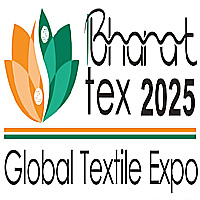Important figures from the textile industry, including producers, importers, and exporters, will come together at Bharat Tex 2026 to exhibit their knowledge, cutting-edge technologies, and newest designs.
Bharat Tex in Numbers
- 5000+ Exhibitors
- 12000+ Textile Products
- 6000+ Overseas Buyers
- 220000+ Sq. Meters Area
- 120000+ Trade Visitors
Bharat Tex 2026 will encompass a wide range of sectors within the textile industry, offering a comprehensive showcase of the entire value chain. The sectors represented at the expo include:
- Textile Raw Materials: Featuring exhibitors specializing in cotton, wool, silk, and other natural fibers, alongside synthetic and man-made fibers. This sector focuses on the essential raw materials that underpin textile production.
- Yarns and Threads: Highlighting a diverse selection of yarns, threads, and sewing materials, this sector showcases innovations in spinning, twisting, and blending, essential for textile manufacturing.
- Fabrics: A broad array of fabrics, including woven, knitted, and non-woven textiles, will be exhibited. This sector caters to a wide range of applications, from apparel to industrial uses.
- Home Textiles: Dedicated to textiles for home furnishings such as bed linens, towels, curtains, and upholstery, this sector is a key destination for exhibitors targeting the interior design and home decor markets.
- Technical Textiles: A rapidly expanding sector that presents textiles with specialized functions, including medical textiles, geotextiles, and textiles for the automotive and construction industries.
- Apparel and Fashion: This sector features clothing manufacturers and fashion brands showcasing their latest collections, offering insights into upcoming trends and innovations in the fashion industry.
- Machinery and Equipment: Exhibitors in this sector will display the latest advancements in textile machinery, including equipment for spinning, weaving, dyeing, printing, and finishing, emphasizing the role of technology in modern textile production.
- Dyes and Chemicals: Covering dyes, pigments, and chemicals used in textile processing, this sector focuses on sustainable and eco-friendly solutions that are increasingly important in the industry.
- Sustainable Textiles: Highlighting environmentally conscious practices, this sector features organic textiles, recycled materials, and sustainable manufacturing processes, aligning with global trends toward sustainability.
- Fashion Accessories: This sector includes essential components such as buttons, zippers, labels, and other accessories, crucial for manufacturers looking to complete their product offerings.
Venue: Bharat Mandapam, ITPO, New Delhi


